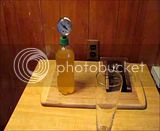RukusDM
Well-Known Member
No! These results do not reflect each other.
Pimento's cider was dry, with just enough priming sugar added to achieve carbonation. It makes sense that it would take a week to two weeks to carbonate. With less sugar in solution, the yeast have a harder time finding it and consuming it. It's the same principle that causes wine and mead to ferment 90% relatively quick, but often that last 10% takes time, usually in an actual secondary vessel. It's the same reason a beer can ferment out in as little as 3 days, but will take a week or two weeks to carbonate because the yeast has settled, there are fewer cells in the bottles, and less sugar added back in.
RukusDM's cider was sweet.... what, like 1.012... and wasn't cold crashed to drop cells, and then even more sugar added to prime. Just because you both had similar results in the time it took to carbonate does not mean you've replicated each other's experiments. I am still having a hard time wrapping my mind around those results. I urge you to repeat this experiment before you draw any conclusions. I once bottled beer with a filthy tube that I didn't sanitize, I also used my mouth to create the siphon, and didn't use mouthwash first. I got no infection. That does not mean it's acceptable practice.
I don't want to crap on your work, I enjoy and appreciate it, especially the water bath temp/time curves.
I think you need to do more research before you draw any conclusions. And as a pessimist, I believe you'll find too many variables that you can't control that will swing the results every time.
How many of the variables are changed when you don't do the testing we have done and bottle carb anyway?
Nothing has changed in the pasteurization method that Pappers has put together other than how we build in a safety by measuring pressure, and use lower temperatures to complete the pasteurization.
I think if you are going to do Pasteurization, you should have a method to measure pressure or you will most defiantly run the risk of popping some.
You think this is less safe than current methods?




